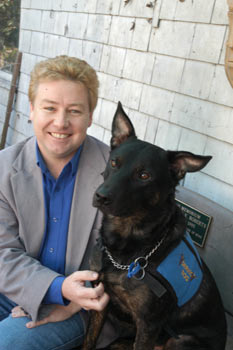|
HOME | SEARCH | ARCHIVE |
|
One in a million? Tell it to the Feds. . .
Hate crimes against disabled people are in a class of their own — one far larger than most law-enforcement agencies acknowledge
![]()
By Kathleen Maclay, Public Affairs
| |
 Hate-crimes researcher Mark Sherry with his service dog, Wally Peg Skorpinski photo |
22 January 2003
|
Disabled people comprise one-fifth of the population in the United States. Yet, according to FBI statistics, they have “just one chance in a million” of being the target of a hate crime in any single year. Berkeley researcher Mark Sherry, author of a new report, “Don’t Ask, Tell or Respond: Silent Acceptance of Disability Hate Crimes,” says those numbers are ludicrously low. Inspired by the song “Mister Cellophane” from the hit musical (and current hit movie) “Chicago,” he calls hate crimes against disabled people “cellophane crimes.” “People walk right through them, look right through them, and never know they’re there,” says Sherry, the Ed Roberts Post-Doctoral Fellow in Berkeley’s fledgling Disabilities Studies program. ‘Virtually unreported’ Despite research that reflects both a high level of disability discrimination and a high rate of crime against the disabled, says Sherry, disability hate crimes are underreported. The voluntary nature of the reporting and the varying time limits for reporting further cloud the issue, he says. Sherry also found that police and prosecutors often abandon the hate crime element in a case and instead call it vandalism, assault, or theft. He says police may doubt they can prove the offender discriminated in the selection of his or her disabled victim — and so instead file charges for an accompanying crime, such as assault. Also, Sherry says, police may not consider a crime victim’s disability as significant as other descriptors. For example, few news reports of the slaying of a young black man in Texas by dragging him behind a pickup truck mentioned that James Byrd also was disabled, Sherry says. Some disability hate crimes aren’t reported by victims because of the victim’s physical need for a third party to relay the information to authorities. Others aren’t reported because the perpetrator is a caregiver upon whom the victim depends. Sometimes police never learn about the crimes because victims consciously or unconsciously ignore the evidence of a hate crime, Sherry says. Among disabled people, he says, hate crimes are often mislabeled “abuse” and dealt with through counseling as opposed to criminal prosecution. In sum, says Jack Glaser, assistant professor at the Goldman School of Public Policy, “the disparity between reporting disability hate crimes and other crimes is staggering. According to Mark’s analysis, disability hate crimes are not just underreported, they are virtually unreported. The number of media stories about them outnumber the statistics.” Low rates of prosecution He reports that while all but five states have hate crime laws, only 23 (including California) provide penalties for disability hate crimes. Federal hate-crime statutes do not include crimes against the disabled, and a proposal to expand the federal definition to include disabled peple stalled in the U.S. Senate earlier this year. Hate crimes in general, says Sherry, suffer from “a notoriously low rate of prosecution and conviction.” Even in Boston, considered a national model for hate-crime investigations, 85 percent of offenders in 452 hate crimes between 1983 and 1987 were not arrested, and a third of those arrested had their charges dropped. And the prosecution history for disability hate crimes in particular? A grand total of one case: that of a cognitively disabled New Jersey man who was kidnapped, attacked, and abandoned in a forest in 1999. A former labor historian, Sherry, who earned his Ph.D. in disability studies at Australia’s University of Queensland in 2002, is currently teaching a course on campus focusing on disability, identity, and social movements. He became acutely aware of disability bias when he was disabled after being run over by a car in 1992; he has spent the last decade recovering from extensive injuries and undergoing numerous surgeries. “That gave me a chance to reflect on the way disability is understood in our society,” he says. While a disabled person generally is viewed as someone who has undergone a personal tragedy, Sherry says he discovered that the disabled are “struggling for better lives and often facing some pretty significant barriers like abuse, discriminatory attitudes, and inaccessible resources.”
Under the Hate Crime Statistics Act of 1990, the FBI has been required since 1997 to collect data on disability hate crimes. The bureau reports that, of 44,265 hate crimes recorded from 1997-2001, some 133 — less than one-half of one percent — were committed against disabled people.
Yet, whatever the numbers, these crimes are quite serious and tend to be particularly violent, says Sherry, with 43 percent of the recorded crimes against disabled people from 1997-2001 involving simple assault. Hate-crime victims are three times more likely to require hospitalization than the victim of a non-bias crime, Sherry adds.
Home | Search | Archive | About | Contact | More News
Copyright 2002, The Regents of the University of California.
Produced and maintained by the Office of Public Affairs at UC Berkeley.
Comments? E-mail berkeleyan@pa.urel.berkeley.edu.